Introduction
In an earlier article I looked at Task and how to track progress and partial results as a Task is running. This can be a challenge, as any Observable value that can be linked to your layout can only be updated from the FXAT, while the action of the Task is designed to be run on a background thread. The usual answer to this is to wrap any calls to update those Observable objects in a Platform.runLater() call.
In that earlier article, we looked at how the Task.updateValue() and Task.updateMessage() methods are designed to limit the number of Platform.runlater() calls that are executed, in order to avoid flooding the FXAT with jobs that would affect the performance of the GUI.
We also looked at creating a custom Property in Task that could be updated in the same manner as Task.value and Task.message and then bound to elements in your layout. Those methods use an internal AtomicReference field, that can safely be updated by multiple threads, to hold an temporary value that can later be transferred to the Property through Platform.runLater().
But AtomicReference relies on an “atomic” getAndSet() method to retrieve and update the value that it holds in a single, thread-safe, operation. But what if you don’t want to replace the value, but add to it?
This is the situaton that you get when your monitored results are in the form of an ObservableList.
What the JavaDocs Say:
Let’s have a look at the informational section at the top of the JavaDocs for Task:
Suppose instead of updating a single value, you want to populate an ObservableList with results as they are obtained. One approach is to expose a new property on the Task which will represent the partial result. Then make sure to use Platform.runLater when adding new items to the partial result.
public class PartialResultsTask extends Task<ObservableList<Rectangle>> { // Uses Java 7 diamond operator private ReadOnlyObjectWrapper<ObservableList<Rectangle>> partialResults = new ReadOnlyObjectWrapper<>(this, "partialResults", FXCollections.observableArrayList(new ArrayList<Rectangle>())); // public final ObservableList<Rectangle> getPartialResults() { return partialResults.get(); } public final ReadOnlyObjectProperty<ObservableList<Rectangle>> partialResultsProperty() { return partialResults.getReadOnlyProperty(); } // @Override protected ObservableList<Rectangle> call() throws Exception { updateMessage("Creating Rectangles..."); for (int i=0; i<100; i++) { if (isCancelled()) break; final Rectangle r = new Rectangle(10, 10); r.setX(10 * i); Platform.runLater(new Runnable() { @Override public void run() { partialResults.get().add(r); } }); updateProgress(i, 100); } return partialResults.get(); } }
They give us “one approach…”, but no more. This approach can work if the the updates to the list are relatively infrequent…

How would you handle a situation where there are thousands of updates to the `ObservableList` from multiple threads that are coming milliseconds apart?
There’s no help from the JavaDocs for this situation.
A Quick Review of the Task.updateMessage()
You really should go back and read that earlier article, but we’ll have a quick look at the process for updating a single value.
Task has a number of Properties that are intended to be updated and changed from background threads, and it is instructive to see how Task internally handles these updates.
Task has a field called message and the infrasture to update it from background threads. The source code for Task.updateMessage() looks like this:
private AtomicReference<String> messageUpdate;
.
.
.
protected void updateMessage(String var1) {
if (this.isFxApplicationThread()) {
this.message.set(var1);
} else if (this.messageUpdate.getAndSet(var1) == null) {
this.runLater(new Runnable() {
public void run() {
String var1 = (String)Task.this.messageUpdate.getAndSet((Object)null);
Task.this.message.set(var1);
}
});
}
}
We have an internal, private, variable called messageUpdate which is an AtomicReference, and that will hold a transient value for updates to the message Property. Because it is an AtomicReference, it is thread-safe, and can be updated freely without concurrency issues.
The updateMessage() method, if run from the FXAT, will simply update Task.message directly.
When called from a background thread, however, it does something more complicated. First, it uses AtomiceReference.getAndSet() to update messageUpdate and to check it’s previous value. If that previous value was null, then it knows that there wasn’t any previous transient value waiting to be transferred to Task.message via Platform.runLater() and it needs to initiate that process. So it creates a Runnable and schedules it on the FXAT via Platform.runLater().
That Runnable does two things:
- It transfers the current value of
Task.messageUpdatetoTask.message. - It sets the value of
Task.messageUpdatetonull.
If Task.updateMessage() is called from a background thread any time between Platform.runLater() being called and the Runnable being executed on the FXAT, then the previous value of messageUpdate will not be null, and it will not, therefore, need to launch a new Runnable on the FXAT. In fact, the only thing that will happen will be that Task.messageUpdate has its value changed. When the Runnable does execute on the FXAT, it will update Task.message with only that latest value that is in Task.messageUpdate.
In this way, Task.updateMessage() allows gazillions of updates from the background threads, but doesn’t flood the FXAT with jobs. As a matter of fact, you never have more than a single job pending on the FXAT at any given time for these updates. Transient values that never make it to Task.message would probably never have made it to the screen if Platform.runlater() had been invoked for every one of them in any case. They certainly wouldn’t have been seen by the user.
About AtomicReference
AtomicReference is thread-safe because its “read” and “set” operations are conducted in a single, “atomic” operation. This means that there’s no possibility that the value could have been changed by some other thread accessing the same object in between the “read” stage and the “set” stage.
But this comes with a cost.
There is no way to modify a value in AtomicReference, we can only replace it. Yes, there is a way to use the current value in an AtomicReference to calculate a new value for it, AtomicReference.getAndUpdate() but this will also replace the value. So, we can do something like this:
val atomicReference = AtomicReference<Int>(10)
val oldValue = atomicReference.getAndUpdate{it + 5}
This allows us to create a new value for atomicReference based on its old value, but doesn’t simply modify the value already inside it.
This means that we cannot do this:
val atomicReference = AtomicReference<MutableList<Int>>(mutableListOf())
val oldValue = atomicReference.getAndUpdate(it.add(5))
because the compiler will complain that it.add(5) returns Boolean when it was expecting MutableList<Int>. This means that we will have to find some other way to deal with it.
Simply Running the Updates in Platform.runLater()
Before we try anything else, let’s see what happens if we take the approach from the JavaDocs, and just put every update on the FXAT via a call to Platform.runLater(). Because, if this works, then we’re all done!
I’m going to use the same type of application that I used in that earlier article, this will make it easier to follow if you did go back and read that article.
class TaskProgress5App : Application() {
override fun start(stage: Stage) {
stage.scene = Scene(createContent(), 800.0, 500.0)
stage.title = "Task Progress Example"
stage.show()
}
@OptIn(ExperimentalAtomicApi::class)
private fun createContent(): Region = BorderPane().apply {
val task = object : Task<Unit>() {
val valueList: ObservableList<String> = FXCollections.observableArrayList()
val waitingEvents = AtomicInt(0)
init {
updateMessage("")
updateProgress(0, 100)
setOnSucceeded { evt -> updateProgress(100, 100) }
}
private fun appendValue(var1: String) {
if (Platform.isFxApplicationThread()) {
valueList.add(var1)
} else {
println("Queuing: ${waitingEvents.incrementAndFetch()}")
Platform.runLater {
println("Performing: ${waitingEvents.decrementAndFetch()}")
valueList.add(var1)
}
}
}
override fun call() {
handleProcessing2(
{ done, total -> updateProgress(done, total) },
{ appendValue(it) },
{ updateMessage(it) })
}
}
center = VBox(10.0).apply {
children += Label().apply {
textProperty().bind(task.messageProperty())
}
children += ProgressBar().apply {
progressProperty().bind(task.progressProperty())
minWidth = 200.0
}
alignment = Pos.CENTER
}
right = TextArea().apply {
textProperty().bind(ListToString(task.valueList))
}
bottom = HBox(Button("Run Task").apply {
setOnAction { Thread(task).start() }
}).apply {
alignment = Pos.CENTER
padding = Insets(20.0)
}
}
}
@OptIn(ExperimentalAtomicApi::class)
fun handleProcessing2(
progressUpdater: (Long, Long) -> Unit,
dataCollector: (String) -> Unit,
messageUpdater: (String) -> Unit
) {
val maxCount = 1000
val threadCount = 50
val job = Runnable {
dataCollector("Thread ${Thread.currentThread().name} starting")
for (x in 0..maxCount) {
dataCollector("Thread ${Thread.currentThread().name}: $x")
Thread.sleep(Duration.ofMillis(10))
}
}
val sTime = LocalTime.now()
progressUpdater(0, 100)
messageUpdater("Initializing")
Thread.sleep(Duration.ofMillis(1000))
progressUpdater(-1, 100)
messageUpdater("Processing")
val threadPool = Executors.newFixedThreadPool(threadCount)
repeat(threadCount) {
threadPool.execute(job)
}
messageUpdater("ThreadPool Started")
threadPool.shutdown()
var counter = 0
while (!threadPool.awaitTermination(4, TimeUnit.SECONDS))
messageUpdater("Still Waiting ${counter++}")
messageUpdater("Completed ${sTime.until(LocalTime.now(), ChronoUnit.MILLIS)}")
progressUpdater(100, 100)
}
class ListToString(private val theList: ObservableList<String>) : StringBinding() {
init {
super.bind(theList)
}
override fun computeValue(): String? =
theList.joinToString("\n")
}
fun main() {
Application.launch(TaskProgress5App::class.java)
}
We have a TextField that has its textProperty() bound to Task.valueList through the Binding called, ListToString. This means that as Task.valueList grows, the text in the TextArea should grow with it.
The background job uses an ExecutorPool of 50 threads to each run a simple job that just generates a String which is passed back to the Task and then sleeps for 10 ms. When the Task gets each String from the background thread, it uses Platform.runLater() to add that String to Task.valueList.
This means that, with 50 threads each generating 1000 Strings, with a 10ms delay between them, we get 50,000 Strings submitted via 50,000 Platform.runLater() calls in a 10 second period. This means it will generate 50,000 FXAT jobs in that 10s.
It looks like this when it is running:
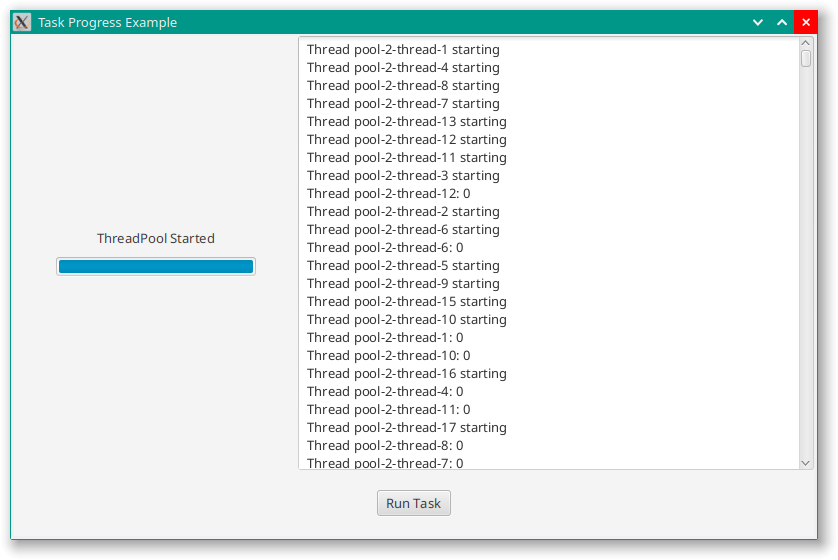
Honestly, when I first ran this without the println() statements, it just looked hung. When I added them, I saw that waitingEvents rose up to 40K+ within a matter of seconds, the Task completed, and then it continued for several minutes to process all of the jobs on the FXAT and decrement the waitingEvents counter.
An earlier version of this code had the ProgressIndicator stay in Indeterminent mode through the processing. It appeared to be stuck while the jobs were being executed. So clearly this approach is not very different from running a long process on the FXAT as far as the GUI responsiveness is concerned.

Never flood the FXAT with thousands and thousands of jobs submitted via `Platform.runLater()`
When the jobs on the FXAT finally all complete, after 10 minutes or more, it looks like this:
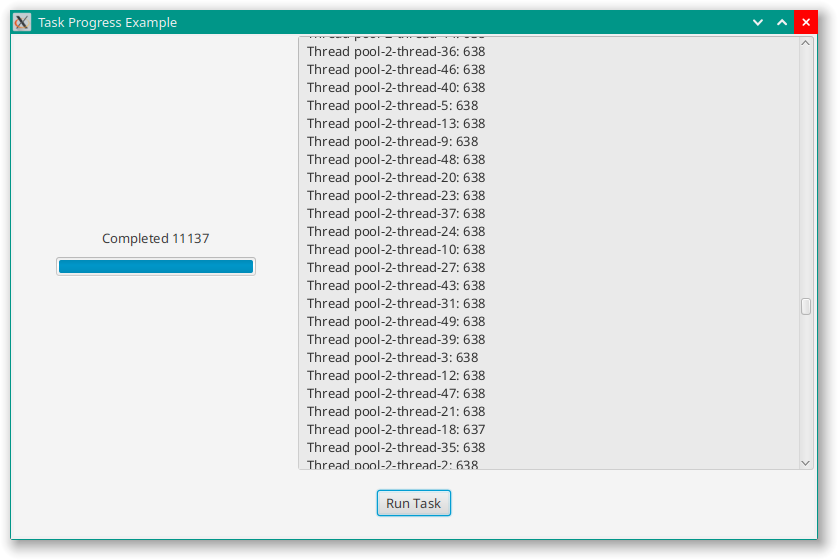
You can see that it took a little more than 11 seconds for the background threads to complete, which seems about right. But the GUI was essentially frozen for the next 10+ minutes while the FXAT jobs were processed.

Clearly, the methodology suggested by the JavaDocs is not a viable approach.
Using Synchronized Operations
The challenge is very well defined at this point. We need to gather our updates together into batches such that we never have more than 1 or 2 jobs in the FXAT to update our ObservableList, but we cannot use the thread-safe Atomic classes to do this. The answer, is to employ locks on our update List so that each thread, including the FXAT, can update it without causing data integrity issues.
Let’s look at how we’ll do this….
The only thing that needs to change is our Task. The inner workings of the update process are hidden from the rest of the code in the application, so it won’t be impacted:
val task = object : Task<Unit>() {
private val dataList = mutableListOf<String>()
val valueList: ObservableList<String> = FXCollections.observableArrayList()
val counter = SimpleIntegerProperty(0)
init {
updateMessage("")
updateProgress(0, 100)
setOnSucceeded { evt -> updateProgress(100, 100) }
}
private fun appendValue(var1: String) {
if (Platform.isFxApplicationThread()) {
valueList.add(var1)
} else {
val sTime = LocalTime.now()
synchronized(dataList) {
if (dataList.isEmpty()) {
Platform.runLater {
val sTime = LocalTime.now()
synchronized(dataList) {
valueList.add(
"FX Event ${counter.value++} happened in ${
sTime.until(LocalTime.now(), ChronoUnit.MILLIS)
}ms\n"
)
valueList.addAll(dataList)
dataList.clear()
}
}
}
dataList.add(var1 + " ${sTime.until(LocalTime.now(), ChronoUnit.MILLIS)}")
}
}
}
override fun call() {
handleProcessing1(
{ done, total -> updateProgress(done, total) },
{ appendValue(it) },
{ updateMessage(it) })
}
}
Here we’ve introduced a private field called dataList which is just a MutableList<String>. This is what we are going to use to “batch” our updates to the ObservableList on the FXAT. The rest of the changes are in appendValue().
If you’ve looked at the source code for Task.updateMessage() above, then you should recognize the pattern here. First, if we are on the FXAT then we just add the value to valueList without any fuss. If we are not on the FXAT, then we need to add our new String to dataList and decide if we need to start a new job on the FXAT. That determination is done by looking at dataList to see if it is empty before we add our new value. If it is, then we need to start a new FXAT job.
That FXAT job does three things:
- Adds a message to
valueListthat says, “FXAT happened”. This way we can track how many updates end up in each update “batch”. - Adds all of the items in
dataListtovalueList. - Clears out
dataList.
All three things are done inside a synchronized block locked on dataList.
The last thing that appendValue() does is to add our new value to dataList after appending some timing information to it.
In order to avoid concurrency problems, all of this activity: checking if dataList is empty, possibly launching a new job on the FXAT and appending the new value to dataList is done in a synchronized block, locking on dataList.
We should look at where this code runs:
- Every call to
appendValue()runs on one of the 50 threads in theExecutorPool. There can, therefore, be multiple simultaneous access from many different threads to this code at any given time. - The code that copies data from
dataListtovalueListand clears outdataListalways runs from the FXAT, and may run at the same time that any number of threads are runningappendValue().
The synchronized blocks around every single access to dataList ensure that only one thread can execute code in either of those two blocks at any given time.
This means that when a background thread is adding a new value to dataList, no other background threads can do the same thing, and the synchronized block inside the job on the FXAT cannot run either. When the job on the FXAT is running, no other background thread can enter the synchronized block in appendValue(). If they cannot enter, they wait.
For this reason, the time calculation code doesn’t just return 0 every time. This information in the output will tell us how long any threads had to wait for other threads to complete their processing first. There’s a time calculation on both the background threads and the FXAT job. We also count how many times it runs the FXAT job.
It looks like this:
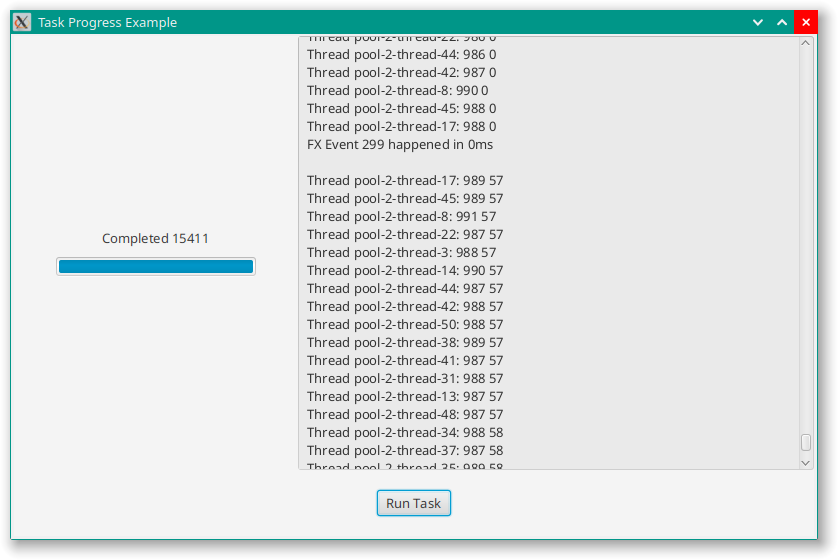
We can see that it now took about 15.5 seconds to complete the background task. This means that the synchronization locking caused an approximate, cumulative 4 seconds of waiting time.
On the other hand, the process finished almost immediately after the background tasks completed. At no time did the GUI appear frozen or unresponsive, and everything seemed to operate smoothly.
You can also see from the screensnap, that the FXAT job was invoked 299 times in that 15 seconds. It never seemed to have to wait.
About that Binding
In this example, the contents of the TextArea reflect the contents of Task.valueList through a custom Binding:
class ListToString(private val theList: ObservableList<String>) : StringBinding() {
init {
super.bind(theList)
}
override fun computeValue(): String? =
theList.joinToString("\n")
}
This might seem a little “heavy handed” at first. The entire String is rebuilt every time that the ObservableList changes. Surely it might be better to put a ListChangeListener on valueList instead, and then just apply the changes to the TextArea?
-
We really cannot make any assumptions about how the layout is going to use the
Propertiesthat we expose from ourTask. We need to design our implementation such that any “normal” usage of thePropertyis going to be functional. That includes a “heavy-handed”Bindinglike this. -
Remember that
Stringin Java is immutable. So any attempt to append data to aStringis going to result in copying the entireStringover and adding the new text. Is this more efficient thanList.joinToString()? Maybe, but it’s probably more a matter of degree than magnitude.

Bindings are recalculated in-line with the code that invalidates their dependencies.
Bindings are not executed through EventHandlers that are submitted as new jobs an the FXAT. This means that you can measure their impact on performance directly. In our FXAT Runnable if we move the code that generatest the “FX Event…” text from the top of the synchronized block to the bottom - after valueList has been modified, and after the ListToString.computeValue() has run - we get this:
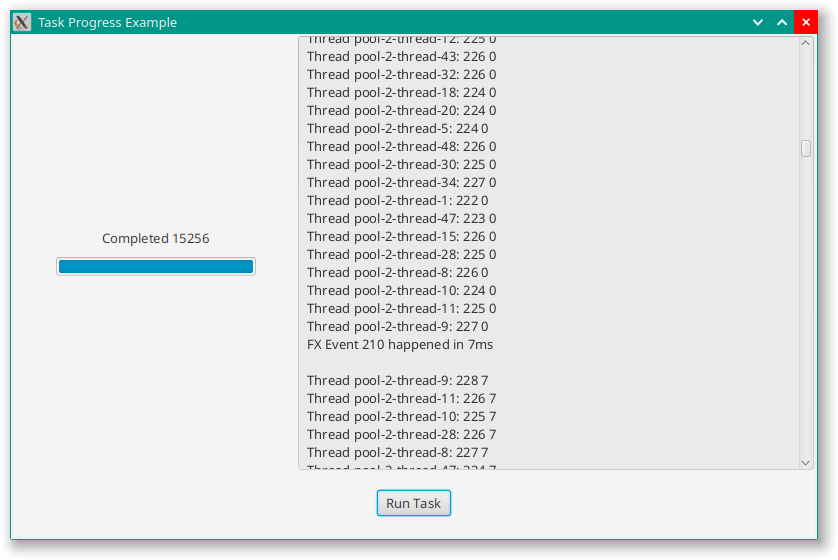
and this:

You can see the top and the bottom of the timings, and as valueList gets bigger, the times get longer. I checked and this is a progression through the output.
I noticed that the first few elements added to each batch picked up measurable delays as the processing went on. This was because the FXAT job started to take longer and longer to complete, so more background tasks (which completed very quickly) got backed up waiting for the FXAT job to release the lock.
I also noticed that the number of elements in the batches got larger as the processing went on. Once again, the increased time for the FXAT job to release the lock meant that more background threads completed their sleep(10) while the lock was on, and therefore contributed to the batches. Eventually, the wait became longer than the 10ms sleep time, so every batch included contributions from every thread.

Is there anything we can do here to limit the time that the FXAT job spends in the syncronized block?
Absolutely! We need to extract the values from dataList and then clear it out inside the synchonized block, but we don’t have to update valueList inside the synchronized block, since we can only ever update it from the single FXAT thread:
private fun appendValue(var1: String) {
if (Platform.isFxApplicationThread()) {
valueList.add(var1)
} else {
val sTime = LocalTime.now()
synchronized(dataList) {
if (dataList.isEmpty()) {
Platform.runLater {
val sTime = LocalTime.now()
val tempList = mutableListOf<String>()
synchronized(dataList) {
tempList.addAll(dataList)
dataList.clear()
valueList.add(
"FX Event ${counter.value++} step 1 in ${
sTime.until(LocalTime.now(), ChronoUnit.MILLIS)
}ms"
)
}
valueList.addAll(tempList)
valueList.add(
"FX Event ${counter.value++} done 1 in ${
sTime.until(LocalTime.now(), ChronoUnit.MILLIS)
}ms\n"
)
}
}
dataList.add(var1 + " ${sTime.until(LocalTime.now(), ChronoUnit.MILLIS)}")
}
}
}
Here, I’ve added a tempList local variable which is just a MutableList<String>. The elements from dataList are extracted into it, dataList is cleared and the lock is released. Then, outside of the synchronized block, the contents of tempList are added to valueList and the ListToString Binding will run. The output looks like this:

You can see that we’ve stripped away almost 3 seconds from our background task runtime. In fact, this is now only a little more than 1 second longer than the first version, without any locking at all. I’ve added an intermediate timer, so you can see how long the synchronized part takes, and it’s usually 0ms. The Binding step seems to take longer now. This may reflect a bigger continual load on my CPU from the background threads that possibly slows down the FXAT.
In my testing, I found that everything continued to work fine, even as I lowered the sleep duration in each thread down to one or two milliseconds.
Returning a Value
What we’ve done so far is good, but it falls short of solving Task as an accumulator that delivers a final value.
The problem is that Task.value is private, and Task.valueProperty exposes Task.value as a ReadOnlyObjectProperty, even to sub-classes of Task. The only way that we can update Task.value is by calling Task.updateValue(), and this uses the same AtomicReference logic as we saw in Task.updateMessage(), it won’t work when we are trying to add items to a List.
It’s one thing to add a custom valueList and expose that to the layout, but if we want our Task to work in a more generic fashion, then we need to have some way to transfer valueList to Task.value when the processing is complete. So, this is the last item we need to address.
There’s one issue that comes from using Platform.runLater() to batch update the ObservableList. The Task is virtually guaranteed to complete before the all the jobs have been run on the FXAT.
We saw this with the first version, just launching many, many jobs using Platform.runLater(). The Task completed minutes before all of the jobs had been run on the FXAT, and any layout updates that would be triggered by the completion of Task would be incorrect.
Let’s see how this impacts the layout. To make things simpler, and easier to see where there are issues, we’ll make the results of the Task the size of the ObservableList instead of the List itself:
private fun createContent(): Region = BorderPane().apply {
val task = object : Task<Int>() {
private val dataList = mutableListOf<String>()
val valueList: ListProperty<String> = SimpleListProperty(FXCollections.observableArrayList())
val counter = SimpleIntegerProperty(0)
val manualSize = SimpleIntegerProperty(0)
init {
updateMessage("")
updateProgress(0, 100)
setOnSucceeded { evt -> updateProgress(100, 100) }
}
private fun appendValue(var1: String) {
if (Platform.isFxApplicationThread()) {
valueList.add(var1)
} else {
val sTime = LocalTime.now()
synchronized(dataList) {
if (dataList.isEmpty()) {
Platform.runLater {
val sTime = LocalTime.now()
val tempList = mutableListOf<String>()
synchronized(dataList) {
tempList.addAll(dataList)
dataList.clear()
valueList.add(
"FX Event ${counter.value++} step 1 in ${
sTime.until(LocalTime.now(), ChronoUnit.MILLIS)
}ms"
)
}
valueList.addAll(tempList)
valueList.add(
"FX Event ${counter.value++} done 1 in ${
sTime.until(LocalTime.now(), ChronoUnit.MILLIS)
}ms\n"
)
}
}
dataList.add(var1 + " ${sTime.until(LocalTime.now(), ChronoUnit.MILLIS)}")
}
}
}
override fun call(): Int {
handleProcessing3(
{ done, total -> updateProgress(done, total) },
{ appendValue(it) },
{ updateMessage(it) })
val tempSize = valueList.size
Platform.runLater { manualSize.value = tempSize }
return valueList.size
}
}
center = VBox(10.0).apply {
children += HBox(
10.0,
promptOf("Manual Size:"),
Label().apply { textProperty().bind(task.manualSize.asString()) })
children += HBox(
10.0,
promptOf("Counted Size:"),
Label().apply { textProperty().bind(task.valueList.sizeProperty().asString()) })
children += HBox(
10.0,
promptOf("Task Value:"),
Label().apply { textProperty().bind(task.valueProperty().asString()) })
children += HBox(
10.0,
promptOf("Task Completion:"),
Label("None").apply {
task.setOnSucceeded { evt -> this.text = task.get().toString() }
})
children += Label().apply {
textProperty().bind(task.messageProperty())
}
children += ProgressBar().apply {
progressProperty().bind(task.progressProperty())
minWidth = 200.0
}
alignment = Pos.CENTER
}
right = TextArea().apply {
textProperty().bind(ListToString(task.valueList))
}
bottom = HBox(Button("Run Task").apply {
setOnAction { Thread(task).start() }
}).apply {
alignment = Pos.CENTER
padding = Insets(20.0)
}
}
In the layout, I’ve added a few Labels to display various values of the size of Task.valueList:
- The one tagged with “Counted Size” is simply bound to the size of the
Task.valueList. I switchedvalueListover to aListPropertyinstead of just anObservableListbecauseListPropertyhas asize Property. - The one tagged “Manual Size” is bound to a
IntegerPropertythat I added totaskcalledmanualSize. The value is updated manually bytask.call(). - The one tagged with “Task Value” is bound to
task.valueProperty. - The one tagged “Task Completion” is manually updated through the
task.onSucceeded Property, which callstask.get().
All together, this is probably over-kill, but you’ll see the problem.
The type of task was changed from Void to Int so that we now have a value that we can grab. Ordinarily, for something like this, you’d probably make the type of task an ObservableList, but keeping it as Int makes it easier to see the issues here.
Aside from the added and changed Properties in task, the only other change was in task.call(), which now looks like this:
override fun call(): Int {
handleProcessing3(
{ done, total -> updateProgress(done, total) },
{ appendValue(it) },
{ updateMessage(it) })
val tempSize = valueList.size
Platform.runLater { manualSize.value = tempSize }
return valueList.size
}
As you can see, task.call() now returns Int. Three lines have been added to the bottom of this method. First we create a local variable called tempSize and initialize it with the size of valueList. To update task.manualSize we need to be on the FXAT, so we’ll need Platform.runLater() here. Then, finally, we return valueList.size.
A few points:
Task.call()itself runs in a background thread.- We don’t really know what invokes
Task.call(). - Whatever value goes into
Task.valuehas to be updated on the FXAT. This means that whatever callsTask.call()and receives an answer will need to invokePlatform.runLater()to updateTask.value. This implies some kind of delay between the end ofTask.call()and the update ofTask.value().
Here’s the results:
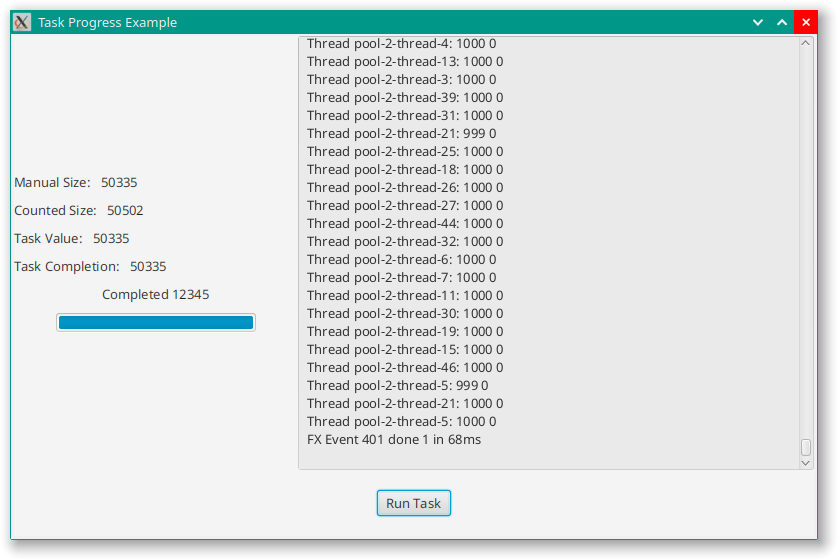
There’s the problem!
The actual, final size of valueList after all the FXAT jobs have completed is 50,502. The size of valueList at the moment that task.call() completed was only 50,335. The value that was captured by Task.onSucceeded and the value that went into Task.value was 50,335.
I think you can see that if you weren’t interested in the size, but actually wanted Task to return the List itself, you’d be short almost 200 entries.
The Key Element of the Problem
The crux of the problem is that Task is designed such that Task.call() returns a value and that value is manually used to update Task.value. However, Task.call() runs on a background thread, which means that updates to the accumulating return value, running on the FXAT, may not have completed at the time that Task.call() completes.

How do we ensure that `Task.call()` does not complete before all of the jobs running on the FXAT that are updating the results have completed?
It turns out that the key factor is that Task.call() runs on a background thread. This means that we have no problems running Thread.sleep() inside Task.call(). All we need is a way to determine if all of the jobs on the FXAT have completed!
Pausing at The End of Task.call()
Before we go there, let’s have a look at how the ThreadPool is handled:
val threadPool = Executors.newFixedThreadPool(50)
repeat(50) {
threadPool.execute(job)
}
messageUpdater("ThreadPool Started")
threadPool.shutdown()
var counter = 0
while (!threadPool.awaitTermination(4, TimeUnit.SECONDS))
messageUpdater("Still Waiting ${counter++}")
That while{} statement is important. More correctly, the ThreadPool.awaitTermination() is very important. This ensures that our method, running on the main background thread, doesn’t return until after all of the jobs running on all of the threads have completed and the ThreadPool has shutdown.
So, when we return from handleProcessing3(), we know that there are no more updates coming to Task.dataList from any background threads.
This means that the only way that Task.dataList can change after we return from handleProcessing3() is from a job on the FXAT. And we know that the only change that such a job makes to Task.dataList is to clear it out.
Now we know how to determine when the last FXAT job has run, and the updates to Task.valueList are complete…when Task.dataList is empty!
And since we are still running on a background thread in Task.call(), we can wait for it!
override fun call(): Int {
handleProcessing3(
{ done, total -> updateProgress(done, total) },
{ appendValue(it) },
{ updateMessage(it) })
while (!dataList.isEmpty()) {
updateMessage("Waiting for completion: ${dataList.size}")
println("Waiting for completion: ${dataList.size}")
Thread.sleep(10)
}
Thread.sleep(100)
updateMessage("All jobs completed")
val tempSize = valueList.size
Platform.runLater { manualSize.value = tempSize }
return valueList.size
}
I’ve added a little while{} loop that uses sleep(10) to wait for the last FXAT job to run. The first time I ran this I didn’t have the last sleep(100) after the while{} loop and it still gave incomplete results.
Remember how we used a temp variable to hold the contents of dataList so that we could clear out dataList and release the lock so that the background threads could start loading it up again without waiting for the Binding.calculateValue() to run? Well that was causing a time difference between the clearing of dataList and the population of valueList on the FXAT, and we need to account for it here.
That last Thread.sleep(100) gives the FXAT enough time to complete the update of valueList after dataList has been cleared out.
This is what it looks like when it’s done:
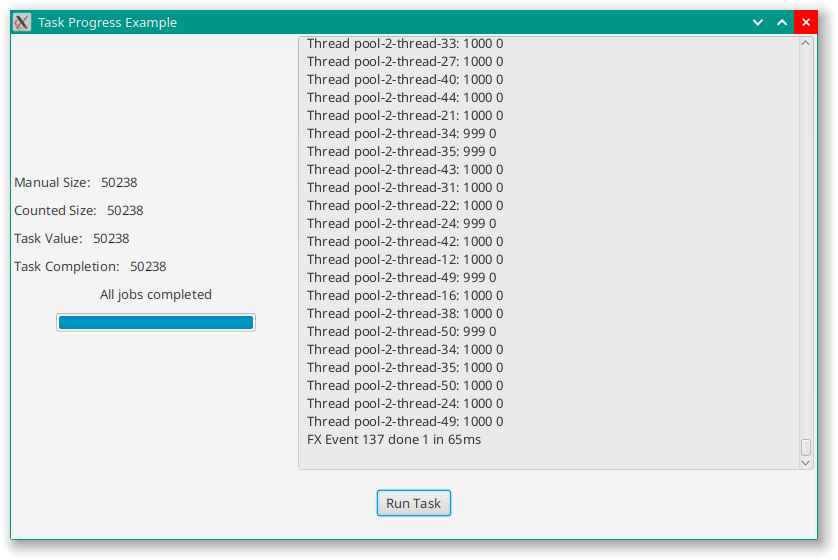
As you can see, the last FXAT update takes 65ms to run, so the 100ms sleep is long enough to handle this.
And this is the console output:
> Task :run
Waiting for completion: 2319
Waiting for completion: 2319
Waiting for completion: 2319
Waiting for completion: 2319
Waiting for completion: 2319
Waiting for completion: 2319
Waiting for completion: 2319
Waiting for completion: 2319
Waiting for completion: 2319
Waiting for completion: 2319
Waiting for completion: 2319
Waiting for completion: 2319
Waiting for completion: 2319
Waiting for completion: 2319
Waiting for completion: 2319
Waiting for completion: 2319
Waiting for completion: 2319
Waiting for completion: 2319
Waiting for completion: 2319
Waiting for completion: 2319
You can see that the while{} loop with the sleep() ran about 20 times. And now the counts are all the same, and correct.
Conclusion
I think that the way that Task is designed to handle frequent updates from background threads is absolutely brilliant. There a number of things to learn from this:
Use Task!
Somehow, people seem to think that using Task is a heavyweight approach to background processing, and they prefer to just drop a Runnable into a new Thread and let it go.
But Task is designed to provide the integration between your GUI and your background job, and to provide it in a way the behaves nicely with the FXAT. This is one place where the JavaDocs are dead-on:
A fully observable implementation of a FutureTask. Task exposes additional state and observable properties useful for programming asynchronous tasks in JavaFX, as defined in the Worker interface.
So use it. Use it every time!
Look at the JavaFX Source Code
Sometimes, in the JavaDocs there are hints about interesting things that you simply cannot appreciate until you look “under-the-hood” and see how it is done. Check out the JavaDocs for Task.updateMessage():
Updates the message property. Calls to updateMessage are coalesced and run later on the FX application thread, so calls to updateMessage, even from the FX Application thread, may not necessarily result in immediate updates to this property, and intermediate message values may be coalesced to save on event notifications.
I’m not sure that “coalesced” is the right word here, since it doesn’t combine them together but simply replaces older, unprocessed, values with newer ones. But this description strongly hints at something interesting going on behind the scenes.
Looking at the source code for things like this shows you the proper way to handle complex issues with JavaFX. Don’t be scared to look, and most IDE’s will take you right to the internal source code from the method call in your application code with a single click.
Only Use Platform.runLater() Thoughtfully
I constantly see people online recommending, “Wrap it in Platform.runLater()”. I see this in tutorial articles as well as discussions and on StackOverflow.
I consider this to be an anti-pattern, if not an out-and-out “code smell”.
Sure, in the solution presented here we did use Platform.runLater(), but in a considered and deliberate manner. And also, it was wrapped inside a utility class and not integrated with any of the application/business logic at all.
You may have noticed that code in handleProcessing() never changed throughout all of the examples in this article. That’s because it’s logic was decoupled from the logic in the Task. We updated Task.call() and Task.appendValue(), but never had to touch the business logic.
At the other end, the GUI was connected to the Task through that ListToString Binding. That Binding is owned by the layout, as are all other elements related to how the layout utilizes the results, and the partial results, from the Task. If it turned out that the ListToString was causing performance issues with the GUI, then that’s the layout’s problem to solve.
Honestly, converting the ObservableList to a String to display it in a TextArea is a pretty bad design decision. It would be much better to use a ListView which is designed to be used in this manner. You could even change the output from String to some structured object, and then have better data available to format the display of the information.
Beware the JavaDocs
While the actual code that runs JavaFX is often brilliant, the associated JavaDocs often are sorely lacking. In this particular example, the approach suggested by the JavaDocs is just bad - wrong even.
What is also interesting is that the JavaDocs for Platform.runLater() contain this warning:
NOTE: applications should avoid flooding JavaFX with too many pending Runnables. Otherwise, the application may become unresponsive. Applications are encouraged to batch up multiple operations into fewer runLater calls.
The approach suggested by the JavaDocs for Task totally disregard this warning.
I wish I could say this was a unique occurance, but lots of JavaDoc entries have dubious advice in their introductory sections.
Multi-threading is Always Complicated
In this application we had three kinds of threads:
- The FX Application Thread (FXAT)
- The main background thread to manage the processing
- 50
ExecutorPoolthreads that did the actual work
It was extremely important to keep track of what activities take place on which thread. For instance, the main background thread controlled the completion of the Task.call() logic. It was extremely important that this thread not run on to completion before all of the ExecutorPool threads had finished.
These three thread types all shared access to one data element, Task.dataList. Understanding how each thread used this data element and how access needed to be controlled to ensure that concurrency issues did not arise was key to architecting the solution properly. We saw how keeping hold of the lock unnecessarily in the FXAT caused the entire process to take almost 3 seconds longer.
This Solution is Still a Bit Kludgey
One thing that I do not like about this approach is that the intermediate results, while the Task is running, are accessed from the Task differently from how the final result is accessed.
To be clear, you can still always access the final result from Task.valueList, but the rest of the Task infrastructure is designed around the result being in Task.value. For instance, Task.get() delegates to Task.value.get().
But, unfortunately, there’s no clean way to get the partial results into Task.value because it’s private to Task and can only be updated through Task.updateValue(). Yes, you could copy the entire ObservableList in Task.valueList over, but that doesn’t seem to meet the definition of “clean” to me.
There doesn’t seem to be any way to create a replacement for Task that accumulates rather than replaces, and still works the same way as Task.
You cannot achieve this by extending Task because key elements are private, and key methods are final. You cannot simply use Task as a basis to create a brand new class that implements FutureTask and Worker because Task uses methods from JavaFX packages that aren’t exported to outside modules. This makes it very difficult to implement the Event firing mechanism in Task.
Maybe there is a better way to craft this into a generic solution that can be added to a library, but I can’t find it.